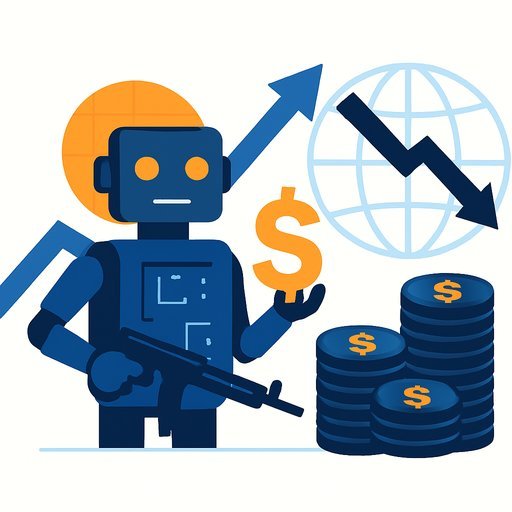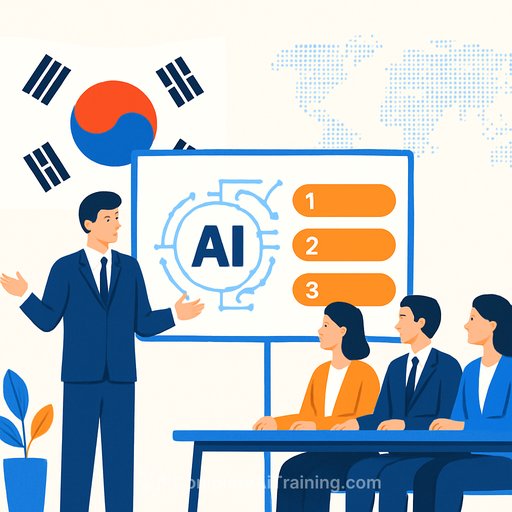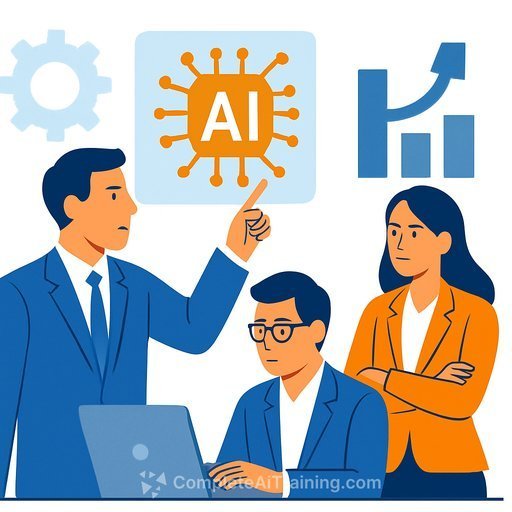How Boards And Executives Can Work Together On AI
AI is changing how decisions are made, how value is created and how teams work. The mandate is clear: treat AI as a business redesign, not a tool rollout.
Senior advisors working with large enterprises say 60% to 70% of work in a typical organization can be automated. That doesn't mean mass job loss. It means hiring and advancement will favor people who can direct and QA AI, while focusing humans on ambiguous problem solving, communication and change management.
From Tools To Transformation
AI should replace meaningful portions of repetitive work-not just "assist." The win is freed capacity that gets redeployed to higher-value activities, not bloated task lists with new software on top.
Think in workflows, not features. Redesign the process end-to-end, then slot AI where it trims time, reduces errors and improves consistency.
Faster Decisions, Fewer Meetings
AI compresses cross-functional decisions. It pulls data across silos, assembles options and surfaces tradeoffs so meetings focus on the decision, not coordination.
Use cases with immediate ROI: contract verification, policy compliance checks, pricing and promo analysis, and service triage. Keep a human-in-the-loop for validation.
What Great AI Leadership Looks Like
The best leaders pair bold ambition with humility. Set a clear, company-wide aspiration for where AI will create value. At the same time, acknowledge uncertainty in P&L impact, workforce effects and timing-and adapt in public.
Where Boards Add Real Value
Boards see the whole business. They connect function-level pilots to enterprise strategy, capital allocation and risk posture. They also balance "keep up" pressure with responsible, sustainable scaling that doesn't damage the talent pipeline.
What Boards Are Asking Right Now
- Strategy: Where does AI create durable advantage? Where could we be disrupted?
- Build/Buy/Partner: What do we develop, acquire or partner for-and why?
- Capital: What's the staged investment plan by use case, with kill or scale gates?
- Talent: Who owns AI delivery? What upskilling is required across the org?
- Pipeline: How do we keep strong entry-level cohorts while automating routine work?
- Economics: Are elite AI hires treated as investments that reduce training and deployment costs later?
- Risk & Governance: Data, model risk, compliance, security and vendor exposure.
How Executives Should Engage The Board
- Frame the thesis: Where AI ties to the business model, not a tech wishlist.
- Show a roadmap: 12-18 months, 5-7 high-impact use cases, with milestones and success criteria.
- Define guardrails: Data access, human oversight, auditability and incident response.
- Measure what matters: Time-to-decision, error rates, unit economics-not vanity metrics.
- Present a workforce plan: Roles to redeploy, skills to develop, hiring for gaps and an entry-level pipeline that still builds future leaders.
- Outline risk controls: Compliance, security, model monitoring and third-party governance.
- Be transparent on uncertainty: Share assumptions, options and trigger points.
A 90-Day Joint Agenda
- Weeks 1-2: Agree on three enterprise outcomes (e.g., reduce cycle time, cut support costs, improve conversion). Map the top 10 repeatable workflows tied to those outcomes.
- Weeks 3-4: Select 3-5 use cases for pilot. Define owners, data needs, guardrails and success metrics. Start a data quality audit.
- Weeks 5-8: Launch pilots with human-in-the-loop. Track time saved, error reduction and decision speed. Stand up model monitoring and a simple risk register.
- Weeks 9-12: Review results with the board. Scale winners, kill laggards, update the capital plan and lock an adoption plan (training, playbooks, comms).
Metrics That Matter
- Cycle time per workflow and time-to-decision
- Error rates, rework and exceptions
- Unit economics: cost per ticket, cost per lead, cost per invoice
- Working capital impact from faster processing
- Customer and employee satisfaction (CSAT/NPS, adoption/usage)
- Model drift, incidents, compliance exceptions and remediation time
Practical Guardrails
- Human-in-the-loop for high-impact decisions and external content
- Data minimization and access controls; no sensitive data in public models
- Red-teaming, hallucination tests and sandboxed evaluations before scale
- Vendor diligence: security, SLAs, IP and indemnities
- Provenance for generated content; clear labeling in customer touchpoints
- Documentation: prompts, model versions, decisions and outcomes for audit
Talent Strategy Without Breaking The Bank
Treat key AI hires as part of the investment that saves training and deployment spend later. Build a small center of excellence to set standards, then upskill the bulk of the workforce by role.
- Upskill managers to redesign workflows and measure gains.
- Train operators to QA AI outputs and escalate exceptions.
- Develop prompt and automation skills where they move core KPIs.
If you need structured programs, see curated options for executives and teams at Complete AI Training by job and role-based certifications at Popular AI Certifications.
Context For Leaders: Policy And Markets
H-1B visas: A recent proclamation reportedly raises the fee to $100,000 for new applicants. Expect pressure on tech talent pipelines and early-stage budgets if enacted. For program background, see the U.S. government's overview of H-1B visas at USCIS.
Interest rates: The Federal Reserve's latest quarter-point cut eases borrowing costs for companies and consumers. That supports AI investment, refinancing and demand. Read policy updates at the Federal Reserve.
Regulatory climate: Media and platform actions facing political pressure are a reminder to stress-test AI content, compliance and governance under shifting rules. Keep documentation tight and approvals clear.
Board-Ready Prompts For Your Next Meeting
- Which three workflows, if improved by 30% this year, would move our P&L the most-and how can AI help?
- What is our policy for human review by decision class, and where do we set thresholds?
- How will we maintain an entry-level talent pipeline as routine tasks get automated?
- What model and vendor risks sit on our critical path, and how are they monitored?
- What do we stop doing once the AI-enabled process is live?
The mandate is speed with stewardship. Pick three high-impact workflows, define the guardrails, measure the gains, and let results-not hype-fund the next wave.
Your membership also unlocks:






